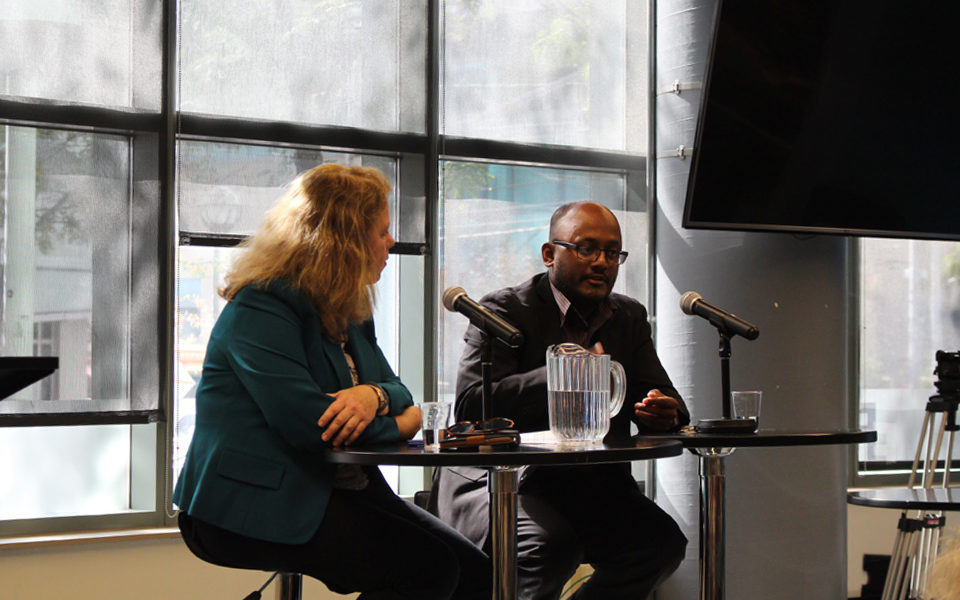
As Hurricane Harvey flooded the streets of Texas, the Islamic State of Iraq and Syria (ISIS) published a post encouraging members to go out and stab people. According to a Newsweek article published on Sept. 6, the post urged members to go to hurricane relief centers and “see if you can help put any kuffs out of their misery.” The term “kuff” refers to the Arabic word “kuffar” which means disbeliever. The article goes on to say that Newsweek was unable to get a comment from the FBI and points out that these extremists rarely act alone.
Amarnath Amarasingam, a researcher at Dalhousie University who specializes in terror and extremism, said this article, and others like it, actually help spread ISIS propaganda. At a Ryerson Journalism Research Centre panel in October about covering extremism in the media, Amarasingam said ISIS’s message initially reached only about 80 people, but because of the article, the call to attack spread much further. He also said the article does more to raise anxieties and scare readers than offer any context to the message.
Amarasingam’s critique puts pressure on newsrooms to better inform readers by providing accurate background information when covering extremism. According to him, an article on ISIS extremists often lacks proper background information on how the individual became radicalized, often leading readers to pin the blame on the larger Muslim community. When, for instance, the suspect in the recent Edmonton attack allegedly drove his car into a police officer and later struck four pedestrians, Edmonton’s Muslim community—most likely fearing retribution—had to publicly denounce his actions. Very little about Sharif’s background has been reported except that there was an ISIS flag in his vehicle and that the RCMP had investigated him in 2015. Because there was no other context, the Muslim community most likely felt they had to take action and ensure the blame was not placed on them, a responsibility they should not have had to field.
NCCM Executive Director Ihsaan Gardee said in a press release that it’s important to show that Muslims are “equal victims of terror.” Barbara Perry, a social scientist and professor at the University of Ontario Institute of Technology, points out that the best way to do this and offer a fair representation of terrorism is to have a “very conscious and self reflective discussion in the media, about what a terrorist is and what has been the role in the media in distinguishing between the two forms.”
“If you don’t know [the background], you can slip into very sloppy reporting, which in this issue can have a lot of damage,” Amarasingam says. “It can have an impact on policy, on how Muslims feel in society, and the question of Islamophobia.”
This oversight is very rarely made when covering white extremists. According to a study by Perry, who has written extensively on hate crime and right-wing extremism, there are over 100 right-wing extremist groups in Canada. A 2015 National Security and Defense Committee report showed that a majority of the extremism files at the Sûreté du Québec, Quebec’s police force, are associated with the right-wing. Despite this, according to Perry, the common stereotype is that Muslims are more likely to be terrorists.
“I think we’re even more obsessed in some ways than the US in Islamist inspired extremism, that we have difficulty seeing those who are like us as terrorist,” Perry said in an interview. This could create a bias within the media that affects the way journalists report on terrorism.
This bias also appears when white terrorists are involved. According to Amarasingam, white converts who commit terrorist attacks on behalf of ISIS are treated much differently in the media than those of Middle Eastern descent.
“All the parents that went public were parents of converts,” Amarasingam said. “They framed it as ‘something happened to my son,’ something out there happened to us Canadians.”
He points out that when the media reports on converts, the stories usually focus on how ‘normal’ the individual was before an outside force came in and changed their perspective, whereas with Middle Eastern individuals, there is often a lot of suspicion and the implication is that something within the Muslim community led to their actions.
Amarasingam attributes this to a leap in judgement made by journalists who believe there is something within the Muslim community that is giving rise to these groups. Instead, he says white supremacist groups are given more caution and journalists are more likely to say that this is a small group of people who have a specific ideology.
However, according to Perry’s study, far-right groups are extremists much in the same way ISIS is. She states, “both Christian and Islamic extremists, for example, are waging a battle to “maintain or restore a social order based on the fundamentals of faith, family and community against a rootless world order of abstract markets, mass politics and a debased sacrilegious ‘tolerance.”
Amarasingam points out that the National Action, a far-right group in England—and all of their front groups—have been listed as terrorist groups. Steps like these have yet to be taken in Canada.